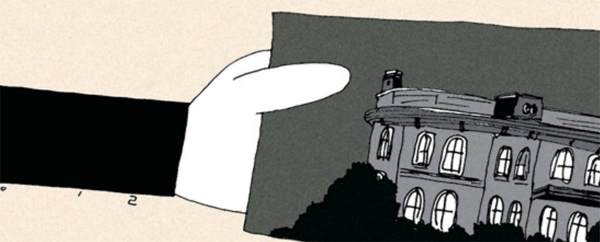A building recalls colonial shame

The Korean Cultural Heritage Administration’s research group showed off the repurchased Korean legation in Washington on Wednesday, exactly 102 years after Japan annexed Korea by force. Thankfully, the interior of the legation building remains close to its original form. The official title of the embassy was the Legation of the Great Korean Empire to Washington. It may have been less tragic if it did not have “great” in the name of the country. The reference to a country on the verge of collapse as “great” amplifies the desperation and sense of crisis of that time.
Senior journalist Hong In-geun, former chief editor of the Dong-A Ilbo and a researcher at the International Center for Korean Studies, translated the records of the Japanese Foreign Ministry and published “Overseas Legations of the Great Korean Empire.” According to Hong’s research, the Japanese empire started political maneuvering to close down overseas missions of the so-called Great Korean Empire on Sept. 6, 1904. Konsuke Hayashi, the Japanese minister in Seoul, sent a lengthy confidential letter to Foreign Minister Jutaro Komura proposing to close down Korea’s overseas legations, starting with recalling its diplomats.
They planned to bring the diplomats back by offering vacations, and then not redispatching them or appointing any successors. The Japanese legations would take over Korea’s diplomatic affairs, and the Korean missions would remain closed. The letter contains provoking and upsetting expressions. “The Korean envoys and officials were dispatched to the countries with diplomatic ties out of the Korean emperor’s vanity, and they are useless, with no missions or international operations.” They treated the diplomats of the Great Korean Empire as useless products of Emperor Gojong’s vanity.
Five months later on Feb. 22, 1905, Japan officially proposed the plan to bring back the diplomats of the Great Korean Empire. Hayashi met with Emperor Gojong and demanded he summon the Korean envoys. While Gojong agreed with the plan in general, he requested the Korean minister to Japan be kept in place in consideration for Korea-Japan relations. Hayashi flatly turned the idea down, calling the measure unnecessary. After the Eulsa Treaty of 1905, through which Japan deprived Korea of diplomatic sovereignty, was signed on Nov. 17, the diplomatic recall unfolded rapidly.
Emperor Gojong paid $25,000 out of his own pocket for the embassy building in Washington, but in 1910, the building was transferred to Japan. It paid Korea $5.
If we forget the painful lessons of history, tragedies may be repeated at any time. Do you recall what happened on Feb. 22, 1905, when Emperor Gojong pleaded to keep the Korean minister to Japan? It was the very day when Japan’s Shimane Prefecture quietly incorporated Dokdo as Japanese territory.
*The author is an editorial writer of the JoongAng Ilbo.
By Noh Jae-hyun










with the Korea JoongAng Daily
To write comments, please log in to one of the accounts.
Standards Board Policy (0/250자)